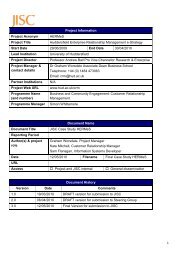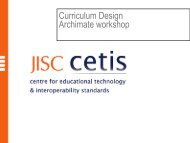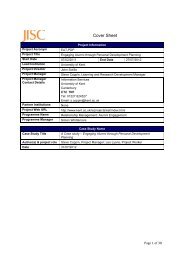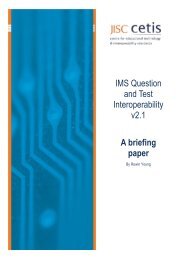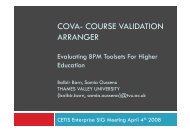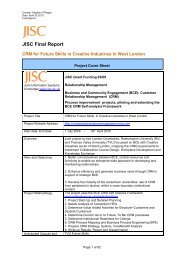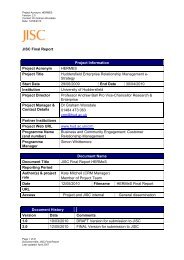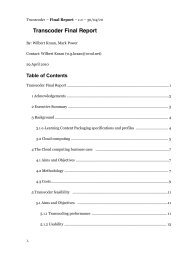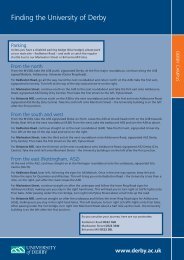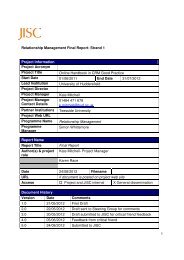A Framework for Rich Interactive Questions for Quizzes ... - CETIS Wiki
A Framework for Rich Interactive Questions for Quizzes ... - CETIS Wiki
A Framework for Rich Interactive Questions for Quizzes ... - CETIS Wiki
Create successful ePaper yourself
Turn your PDF publications into a flip-book with our unique Google optimized e-Paper software.
A <strong>Framework</strong> <strong>for</strong> <strong>Rich</strong> <strong>Interactive</strong><br />
<strong>Questions</strong> <strong>for</strong> <strong>Quizzes</strong> in Mathematical<br />
Sciences<br />
DVLE showcase meeting<br />
Adrian Bowman, Ewan Craw<strong>for</strong>d, Ludger Evers, and John<br />
McColl<br />
January 25, 2011
In case you get bored . . .<br />
. . . you can play with the interactive features (running outside<br />
VLE) at<br />
http://www.mathstore.ac.uk/jisc/<br />
2/23
Key idea<br />
Educational Background<br />
Illustrating theoretical concepts graphically is an important part<br />
of teaching quantitative concepts.<br />
Example:<br />
Consider the linear function f (x) = a + bx.<br />
How to interpret a and b?<br />
f (0) = a<br />
∂<br />
f (x) = b ∀x ∈ R<br />
∂x<br />
3/23
Key idea<br />
Educational Background<br />
Illustrating theoretical concepts graphically is an important part<br />
of teaching quantitative concepts.<br />
Example:<br />
Consider the linear function f (x) = a + bx.<br />
How to interpret a and b?<br />
f (0) = a<br />
∂<br />
f (x) = b ∀x ∈ R<br />
∂x<br />
3/23
Key idea<br />
Educational Background<br />
Illustrating theoretical concepts graphically is an important part<br />
of teaching quantitative concepts.<br />
Example:<br />
Consider the linear function f (x) = a + bx.<br />
How to interpret a and b?<br />
f (x)<br />
f (0) = a<br />
∂<br />
f (x) = b ∀x ∈ R<br />
∂x<br />
a<br />
1<br />
b<br />
x<br />
3/23
Technological background<br />
Modern browser technology allows learners to interact<br />
with figures and illustrations.<br />
VLEs quizzes are built around multiple-choice questions<br />
and standard open questions.<br />
Only static images can be used as illustrations.<br />
IMS QTI only has limited support <strong>for</strong> graphical<br />
interactions.<br />
selecting “hotspots”,<br />
filling “gaps” in an image, and<br />
moving one image on<br />
top of another.<br />
4/23
Extend the functionality of the quiz facility of a VLE by<br />
providing a framework <strong>for</strong> widgets displaying interactive<br />
graphics.<br />
Project aim<br />
5/23
Technological choices: Display graphics<br />
<strong>Interactive</strong> feature should run inside the browser.<br />
Adobe Flash<br />
- Requires proprietary plug-in (not available on all<br />
plat<strong>for</strong>ms)<br />
Java<br />
- Requires plug-in / runtime (not available on all plat<strong>for</strong>ms)<br />
Javascript and SVG/VML<br />
+ Requires no plug-in.<br />
- Differences between Internet Explorer (VML) and other<br />
browsers (SVG)<br />
Our approach: Use Javascript and SVG/VML using Raphaël<br />
<strong>for</strong> browser abstraction.<br />
6/23
Technological choices: Display graphics<br />
<strong>Interactive</strong> feature should run inside the browser.<br />
Adobe Flash<br />
- Requires proprietary plug-in (not available on all<br />
plat<strong>for</strong>ms)<br />
Java<br />
- Requires plug-in / runtime (not available on all plat<strong>for</strong>ms)<br />
Javascript and SVG/VML<br />
+ Requires no plug-in.<br />
- Differences between Internet Explorer (VML) and other<br />
browsers (SVG)<br />
Our approach: Use Javascript and SVG/VML using Raphaël<br />
<strong>for</strong> browser abstraction.<br />
6/23
Technological choices: Integration into VLE<br />
Apache Wookie or IMS Basic LTI<br />
+ Technology already available (although still under<br />
development).<br />
- Tight integration into VLE’s quiz engine not possible.<br />
(passing back of results, etc.)<br />
IMS Simple Outcomes<br />
+ Would do exactly what we want.<br />
- Still work in progress.<br />
Direct integration into VLE’s<br />
- Not really interoperable.<br />
Short term approach: Make all three above approaches<br />
possible (at least in principle)<br />
Long term approach: Use Simple Outcomes.<br />
7/23
Technological choices: Integration into VLE<br />
Apache Wookie or IMS Basic LTI<br />
+ Technology already available (although still under<br />
development).<br />
- Tight integration into VLE’s quiz engine not possible.<br />
(passing back of results, etc.)<br />
IMS Simple Outcomes<br />
+ Would do exactly what we want.<br />
- Still work in progress.<br />
Direct integration into VLE’s<br />
- Not really interoperable.<br />
Short term approach: Make all three above approaches<br />
possible (at least in principle)<br />
Long term approach: Use Simple Outcomes.<br />
7/23
All functionality is present in Javascript.<br />
In principle feature can run without a server.<br />
Some server-side features helpful:<br />
Checking of the student’s answer (otherwise risk of<br />
manipulation).<br />
Not sending model answers until student has finished<br />
attempt.<br />
Storing result in the gradebook of the VLE.<br />
Solution: Modularised Javascript code, which allows<br />
“moving” certain aspects onto a server.<br />
Architecture<br />
8/23
Handling of<br />
variables and object<br />
dependencies<br />
2,442 lines of Javascript code<br />
Drawing of objects<br />
and interaction<br />
7,053 lines of Javascript code<br />
XML processing<br />
Assessment<br />
3,705 lines of Javascript code<br />
1,891 lines of Javascript code<br />
Javascript modules<br />
Communication<br />
with server (if any)<br />
156 lines of Javascript code<br />
9/23
Feature specification: XML<br />
Specification of feature in XML (inspired by QTI)<br />
...<br />
<br />
<br />
<br />
<br />
<br />
<br />
<br />
<br />
...<br />
<br />
<br />
<br />
<br />
<br />
<br />
<br />
<br />
<br />
<br />
<br />
...<br />
10/23
Graphics objects<br />
Basic shapes Ellipses (and circles), paths (lines, rectangles,<br />
polygons, etc.), text, and bitmap images.<br />
Special mathematical objects Linear functions and Hermite<br />
splines<br />
(can be queried <strong>for</strong> derivatives, integrals,<br />
moments, intersections, etc.)<br />
11/23
Interaction (1): Moving objects<br />
12/23
Interaction (2): Selecting objects<br />
13/23
Interaction (3): Drag and drop (matching)<br />
14/23
Organisational problems<br />
Secondment of programmer proved not as straight<strong>for</strong>ward.<br />
Some of the project goals turned out to be very ambitious.<br />
Some aspects not yet finished.<br />
Moodle: Delay of release 2.0. New quiz engine only in<br />
Moodle 2.1<br />
delayed Moodle integration to April 2011<br />
15/23
Technological problems<br />
MSIE: Although Rapahël library should provide browser<br />
abstraction, making the features work on Internet Explorer<br />
was not easy.<br />
MSIE: Javascript engine of Internet Explorer is very slow.<br />
changes to internal architecture (update dependencies<br />
resolved ahead of time and cached).<br />
Javascript is very weak as far as Mathematics is concerned.<br />
Some Statistics-related functionality added.<br />
User can also include Javascript code.<br />
Added “special” objects and queries.<br />
16/23
very easy<br />
Feedback from students: overview<br />
Student testing session with volunteers (18 students)<br />
How easy to use<br />
easy<br />
Not too sure what to do next<br />
Never<br />
Once or twice<br />
Very interesting<br />
How interesting<br />
Interesting<br />
17/23
“Was great fun to use”.<br />
“Makes theory easier to understand”.<br />
Feedback from students: quotes<br />
“Much better than standard-multiple choice. I think it<br />
made me better understand the answers. Not just<br />
guessing.”.<br />
“Won’t get bored that easily, because I get to do things<br />
with the graphs”.<br />
18/23
Feedback from teachers: basic idea<br />
+ “Playing with these graphs can be a powerful learning<br />
tool”.<br />
+ “Makes student experiment a bit with ’I wonder what<br />
happens if . . . ’ kind of scenarios which lead to deep<br />
learning”<br />
- “This is really great, but I think it would take too much<br />
time to set up”.<br />
- Conflict between assessment (time limit, etc.) and<br />
exploration.<br />
19/23
Feedback from teachers: XML<br />
The use of XML is a barrier. Some teachers find it very easy,<br />
other struggle a lot more.<br />
Typical first reaction: “Argh!!! Help!!!”<br />
After having spent time looking at the XML<br />
“With additional help I could modify existing questions,<br />
but not more.”<br />
“I would be happy to learn but probably would need a bit<br />
of a tutorial and help on it.”<br />
“Was easier than I thought it would be.”<br />
20/23
Lessons learned<br />
Organisational Don’t be too ambitious with IT projects.<br />
Secondment arrangements can be tricky.<br />
Educational <strong>Interactive</strong> graphics do improve learning<br />
experience.<br />
Assessment or quizzes might not always be<br />
best framework <strong>for</strong> this.<br />
Technological SVG/VML + Javascript works well <strong>for</strong><br />
interactive graphics.<br />
Though IE has become more<br />
standard-compliant, it requires additional<br />
testing.<br />
21/23
Where to go from here<br />
Next months Integration into Moodle 2.1 as showcase<br />
VLE<br />
Provide a version with assessment stripped<br />
(<strong>for</strong> demos, rather than quizzes)<br />
Provide Wookie versions<br />
Long term Use IMS Simple Outcomes <strong>for</strong><br />
VLE-integration<br />
Provide a GUI-editor <strong>for</strong> features (not relying<br />
on teacher writing XML, very ambitious)<br />
22/23
Play with five questions at (running outside VLE):<br />
http://www.mathstore.ac.uk/jisc/<br />
23/23



